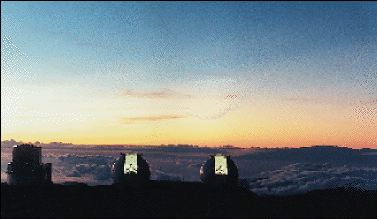R. Winn Hardin
LIVERMORE, Calif. -- A laser system that makes a false star glow in the Earth's upper atmosphere will help astronomers study some of the universe's faintest objects.
The same phenomenon that makes stars appear to twinkle to ground-based observers poses quite a problem for astronomers. Case in point: The 3-m telescope at the Lick Observatory in Mount Hamilton, Calif., should be able to resolve heavenly objects down to 0.15 arc sec at a wavelength of 1 µm, but can achieve only 1 arc sec of angular resolution because of turbulence and temperature fluctuations in the atmosphere.

The optical platform at Keck Observatory will house the adaptive optics and new IR spectroscopy equipment under development by several US national laboratories. Courtesy of Andrew Perala.
|
These fluctuations deform the wavefront of incoming light. To overcome this, astronomers can either use the characteristics of a nearby well-known star as a guide, which limits them to less than 10 percent of the sky, or they can create their own star.
Conventional methods of creating a laser guide star are Rayleigh scattering and sodium fluorescence.
A star to steer by
Rayleigh scattering involves shooting a laser beam at air molecules 10 to 15 km above Earth. This method creates a low-altitude target, inadequate for large-diameter telescopes. The second method uses a laser beam at 589 nm to excite sodium molecules 95 km above Earth into fluorescence.
Claire Max and associates at the Lawrence Livermore National Laboratory have improved on previous sodium laser guide star systems. New, high-order adaptive optics allow astronomers at the Lick telescope to observe a 3.3 increase in stellar intensity and a factor of 2.5 increase in angular resolution during stellar observations.
The laser system built by Herb Friedman of Livermore uses four Nd:YAG lasers to pump a dye tunable laser at 589 nm. The dye laser sends 11,000 pulses per second of 18-W light into the atmosphere. A high-speed charge-coupled device camera developed at MIT Lincoln Laboratories of Lexington, Mass., samples the returning light from fluorescing sodium atoms up to 1000 times per second. This data feeds into a computer that adjusts a deformable mirror. A HeNe laser inside the adaptive optics system acts as a stable reference.
"Not only can you see much more detail, but you can see much fainter objects. That's what you want to see -- distant galaxies and very young objects at high red shift."
Minimizing the angular resolution is crucial because it limits the amount of background light, Max said. "You actually win, by a very large factor, the square of the angular resolution improvement." In this case, astronomers are able to see stars hundreds of times fainter than they could with previous systems.
Max's group is building a second laser system for the Keck Observatory that will use five pump sources and will produce 20 W.
